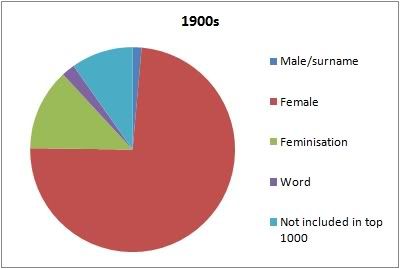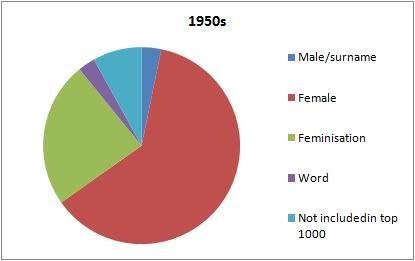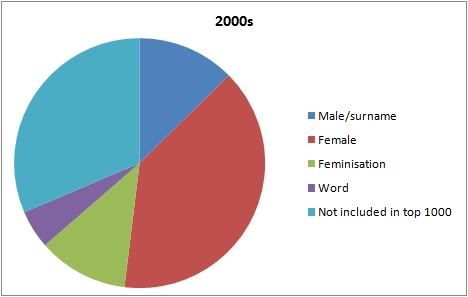In this post, I am aim to look at the changing nature of how masculinity is achieved in female names, with particular attention being given to US. My instinct tells me that in the late 19th and early 20th century, masculinity was found through the feminisation of male names – common examples being Frances, Julia and Josephine, which could be shortened to unisex nickname such as Fran and Joe. Nowadays, the emphasis has shifted to wholesale adoption of male names and surnames on females such as Madison, Alexis and Taylor. Such an adoption has led to a decline in the feminisation of female names, as masculinity can be acquired from adopting male names instead. Through looking at the top 1000 names for the decades of 1900s, 1950s and 2000s, I intend to prove the veracity of this assumption, as well as think about reasons why there has been a change. For each name, I intend to assign whether they are a 'female name', 'male name or surname', 'feminisation of a male name' or a 'word name'. These categories can be defined and explained as followed: Female Name: These are names that do not have an obvious masculine connection. For example, Elizabeth, Sarah, Catherine and Jasmine. Flower and plant names are included in this category, as they are inherently feminine. Male name or surname: These are included together as surnames have traditionally been adopted by males, and more recently have made the cross-over into female names. It can be difficult to separate whether a name was chosen because it was a surname, or because it was associated with being a 'male name'. Examples include Madison, Jordan, Jocelyn and Kennedy. Feminisation of male name: These are male names that have been feminised, usually through the addition of 'a', 'etta', 'elle', or 'ine'. For example, Olivia, Gabrielle, Makayla and Josephine. This category also includes more masculine nicknames that could have come from female names, such as Terry (from Teresa or Terence), Mattie (from Matilda or Matthew) and Allie (from Alexander or Alice). Male nicknames that do not seem to directly derive from any common female name such as Jamie, Jimmie, Tommie and Johnnie are included in the male name or surname category. Word name: These are words and places that have been adopted as names, and do not carry such obvious original gender biases as female names. For example, Destiny, Robin, Brooklyn and Amber. There are various names that do cross categories, and having to organise 3000 names into these categories means that there is room for human error. The intention of compiling these statistics is to look at the broad trends not at individual names, so this should not make much difference to the broad trends. The organised data can be found here. What it shows: First, the obvious – between the 1900s and 2000s, there has been a decline in the % of children being given names in the top 1000. In 1900s and 1950s, around 90% of children were given a top 1000 name, in the 2000s this has declined to 69%. This has the effect that while analysing the top 1000 for 1900s and 50s will be fairly accurate for general name trends, it is difficult to tell whether in the 2000s, if names outside the top 1000 follow the same trends and separate into the same proportions in terms of categories as the names outside the top 1000. It should also be noted that, before I start, the top 1000s from 1900s and 1950s contain male names such as James, William and Charles. The appearance of these names is generally put down to incorrect data input at birth, and assignation of the wrong gender to various names, and studies of other records from the period such as censuses show that that hundreds of parents were not naming their sons Elizabeth and daughters James. In the case of the 1900s records, incorrect assignation of gender comprises less than 0.1% so I have included them, as they make little difference to the overall percentages. 'Female' names have the largest percentage in each of the three time periods, although this proportion decreased over time. In 1900s, almost ¾ of names fall into the 'female' category. By 2000, only close to 40% fall into this category – although 31% of names were not recorded in the top 1000. Similar proportions of feminised names are found in the 2000s and 1900s – around 12%. However, this doubles to 24% in the 1950s. The 1950s seem to be a bridge between the more old-fashioned feminisations such as Ernestine and Alberta, and the newer ones such as Christine and Stephanie. Male names and surnames, and word names barely feature in the 1900s lists. Male names and surnames are mainly bolstered by the appearance of Evelyn – been used as an elaboration of the name Eve and so is one of those names that is difficult to categorise. Word names in the 1900s are formed mainly of jewel names- such as Pearl, Ruby, Opal and Jewel itself, as well as a few place names that have mainly fallen out of use now, such as Missouri and Florida. In the 1950s, male names and surnames, and word names have both increased to 3% each. Male names and surnames is mainly made up of 'y' ending surnames such as Shirley, Beverly, Kimberly and Kelly. Word names are more a mix of places such as Sharon and Shannon, nature names such as Robin, Dawn and Ginger, jewel names, and abstract virtues such as Joy, Faith, Gay and Hope. In the 2000s, there has been a large increase in the number of surname and male names, which now comprise 13% of names. Unlike previously, several male names feature prominently such as Alexis and Morgan. Additionally, the majority of surnames have previously been used as male names such as Ashley, Taylor and Sydney, while there is a small minority that seems to solely have emerged as a female name, such as Madison, Hailey and Courtney. The highest position of a male name or surname in 2000s is #2, held by Madison, and there are three other names from this category in the top 20. In 1950s, the highest position was Joyce at #29, and in the 1900s, it was Evelyn at #38 (or Vivian at #129, or if you want a solidly male name, Bertie at #235). Word names comprise 5% in 2000s, and there seem to be more place and landscape names such as Savannah, Brooke, Sierra, Brooklyn and Brittany. More abstract ideas such as Destiny, Trinity, Genesis and Serenity have also appeared, and these appear arguably to be less connected to traditional virtues. Here are some pie charts that portray visually what I have clumsily tried to explain in words: A few more things to look at, before trying some actual analysis. First, the top 20s. In the 1900s, 18 names from the top 20 fall into the 'female' name category, with the other two – Frances and Bertha, being feminisations. In the 1950s, 5 of the top 20 are feminisations – Patricia (at #3), Sandra, Carol, Brenda and Janet, and one is a word name – Sharon. The rest are female names. The 2000s are much more of a mix- 13 of the names are still 'female', but there are 4 male names or surnames – Madison (at #2), Ashley, Alexis and Taylor, and 2 feminisations – Olivia and Brianna. Some analysis: First, does the gender affiliation of a name really mean anything? We live in a time when gender differences are being downplayed, in favour of equality and women (and men) are told that we can do whatever we want, regardless of the gender divide. Can the way that we choose the names of our children reflect that – that there is now much more emphasis on the choice of both an individual name, and a gender neutral name. Thus the increase in masculine surnames, and male names on females. Of course, there is also the problem that boys are not being given female names – Elizabeth or Mary are not charting as male names. Should we care about such gender differences? Isn't the adoption of masculinity actually an adoption of having the power to determine one's own life rather than being submissively feminine? I am not here to answer such big questions, my interest remains in issues of naming, and I can so I can only see this current spate of adoption of male names on females as a bad thing because it is so one sided. Rejecting female names in favour of male names would be fine if male names were rejected for males in favour of female names, but instead, we are in danger of losing female names. In the 1950s, feminisations of male names were popular – such as Patricia, Sandra and Christine – all of which can be shortened to more masculine nickname such as Pat, Sandy and Chris. Why so? Was this a way of honouring fathers, or a way of giving females stronger nicknames, or a way of increasing the name corpus without resulting – as we have in recent years, to adopting abstract words, male names and surnames. Is the adoption of male names and surnames an attempt at gaining more individuality? Through adopting say, Alexis – known on boys, but originally unknown on girls. These names are recognisable but originally unexpected on girls, similar with the word names such as Destiny. Better communication – especially the internet, means that people are more aware of the popularity of their name in the wider national and global community, and so may aim to have a more individual name for their child. Additionally, there are studies that suggest girls with more feminine names avoid 'masculine' subjects such as maths and science (see here) – desire for girls to have wider opportunities and not tied into their 'feminine' names (of course, you can argue the other way, that women with more masculine names are biased against choosing feminine subjects). Another look at the subject of femininity and masculinity in names is found here . Hopefully, this post provides some information to help look at the subject.
Monday, December 07, 2009
Masculinity and Female Names
Posted by Sarah Francis at 3:28 pm
Labels: baby names, female, male, masculine, names, popular names, usa
Subscribe to:
Post Comments (Atom)




0 comments:
Post a Comment